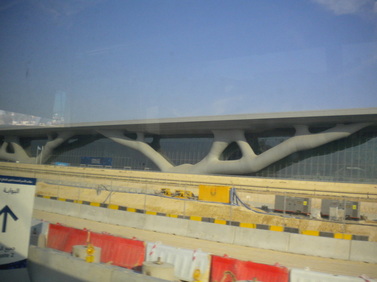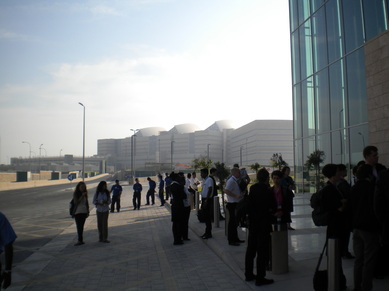
What a busy and exciting day at COP 18! After waking up at the crack of dawn, literally, we headed towards the nearest five star hotels that offered a shuttle to the Qatar National Convention Center (QNCC). The bus ride really made me appreciate the fact that I didn’t have to drive. If you think American drivers are rude and crazy you have never been to Doha. Drivers wait until the last possible moment to merge and when they do its less of a merge and more of a you better stop because I’m cutting you off either way. Our bus was inches away from an accident about every ten seconds. And the congestion from 1.4 million citizens getting around with a practically nonexistent mass transit system was enough to give the calmest of drivers road rage. After a half hour of constantly expecting to be involved in a terrible accident we finally reached the massive QNCC.
The front of the Qatar National Center
There was a lot going on in the convention center and it was a bit overwhelming, but we checked the schedules and figured out what panel discussions and talks we wanted to attend. First on the agenda for this busy Monday was a YOUNGO meeting. YOUNGO is the UNFCCC’s youth non-government organization, or NGO, constituency made up from youth members from all around the world. It was interesting seeing international youth get together for a common cause, but the meeting was abruptly halted shortly after it started by the fire alarm. After being forced all the way to the end of the convention center, past multiple fire exits, to the last set of doors we waited outside for a couple of minutes until they let us back inside. Apparently there was no fire so someone must have pulled the alarm or there was a technical glitch. Back at the YOUNGO meeting we soon realized that we were more interested in the adult side of the COP and took our leave.
Outside during the fire drill
We headed towards one of the exposition halls that contained booths from both government organizations and NGOs. There was a lot of interesting information on display and I took as many free pamphlets that I could. When it was time for the panel discussions and talks to start we walked to another huge expo hall that housed the United States pavilion for a discussion about the Environmental Protection Agency’s Greenhouse Gas Reporting System. It’s interesting that while most of the other countries were discussing limiting greenhouse gas emissions, our government is only concerned about quantifying them for now.
At this point our group of bloggers split up to divide and conquer this COP. With so many things taking place simultaneously we thought it would be best to experience as much as possible. I headed off to a discussion focusing on the European Union’s roadmap to 2050 and its system of emission credit trading. In Europe there is a continental trading market where industries can buy and sell credits to emit greenhouse gases. For each credit sold people in developing countries plant trees or do other things to offset the industrial emissions. It is a good idea but has a major flaw. The system was installed a few years before the financial crisis and when it hit industries stopped producing as much and as a result did not use up the emission credits allocated to them. This has led to a large surplus of emission credits that is keeping their price low. Without a high carbon price there is little incentive for companies to invest in technology and infrastructure that would decrease their carbon footprint significantly. Emission levels are going down but are projected to only decrease by 40% by 2050 instead of the goal of 85-90% that was proposed when the market was created. It is a step in the right direction however and is a much better policy than the US’s which is non-existent.
The giant spider statue in the QNCC
The next panel I attended was on the topic that I am very interested in, carbon capture and storage, or CCS. This panel was specifically on the CCS efforts taking place in the GCC, Gulf Cooperation Council, so it was mainly focused on CCS technologies that benefit the oil industry. A number of representatives from Persian Gulf states described their country’s work with CCS. The main purpose for CCS in this region is for enhanced oil recovery, EOR. Basically conventional means of drilling only remove around 30% of the oil in field. To increase this yield oil companies can pump CO2 down into the reserve and it will push out much of the remaining oil. The idea is the CO2 will remain in the underground fields where it will not contribute to environmental greenhouse gas levels. The problem is the process of capturing CO2, transporting it to the wells, and the infrastructure needed for all of these processes is fairly expensive and the oil companies are not desperate enough to invest as their oil reserves are not at the level where they need to invest. The one country with the exception is Oman where oil production is declining due to difficulties extracting the remaining oil reserves. However recently industries in other GCC states, realizing the importance that this technology could play in combating climate change, have begun building up CCS infrastructure even though it is not yet financially needed yet. It is good to hear that not everyone in industry is solely driven by the almighty dollar.
The rest of the day was spent at a number of other discussions including one on women involvement in combating climate change and two presentations at NASA’s hyperwall, for more information on the hyperwall check out Parker’s blog and Marla’s blog. After such a busy day I am exhausted but definitely looking forward to more discussions and panels tomorrow.




 RSS Feed
RSS Feed